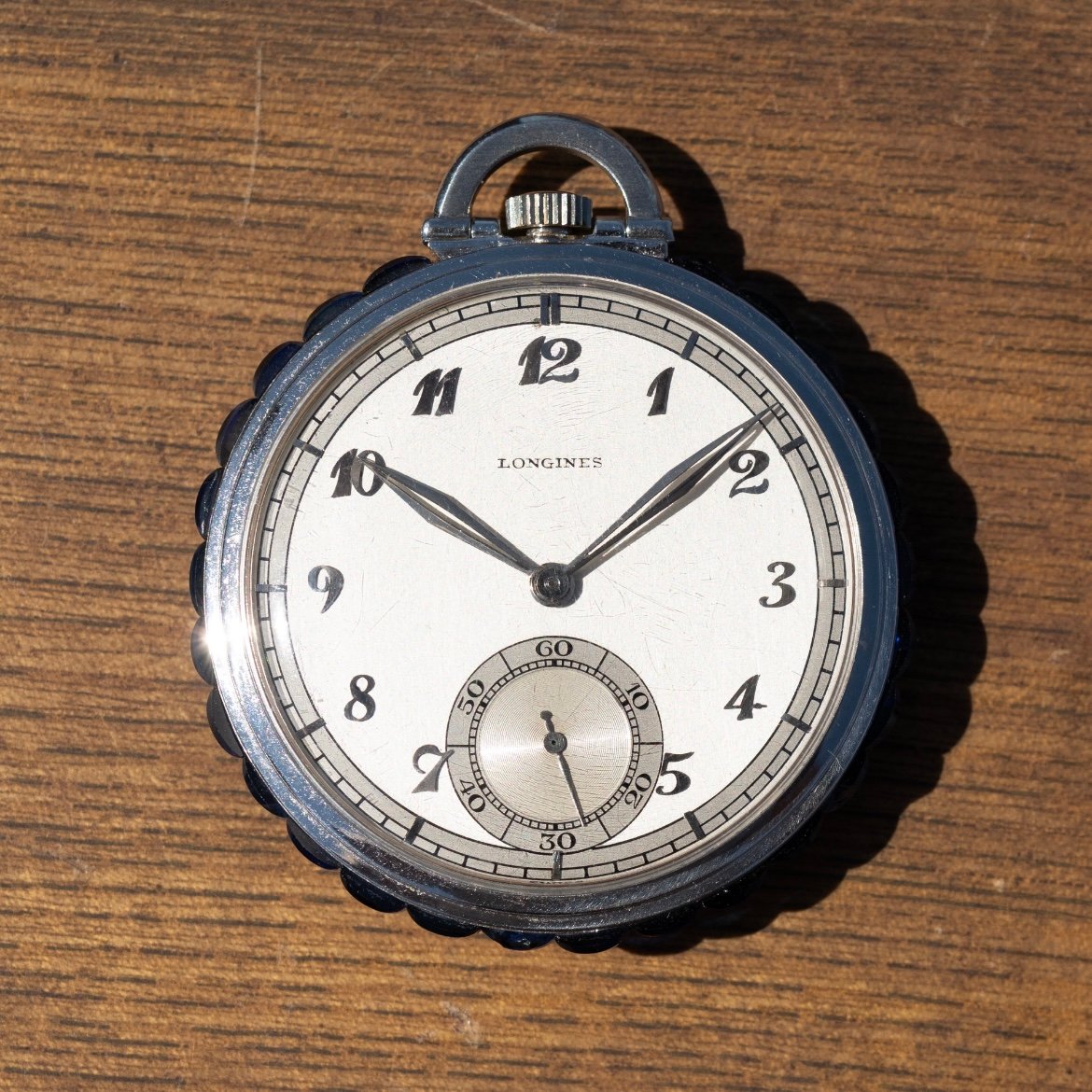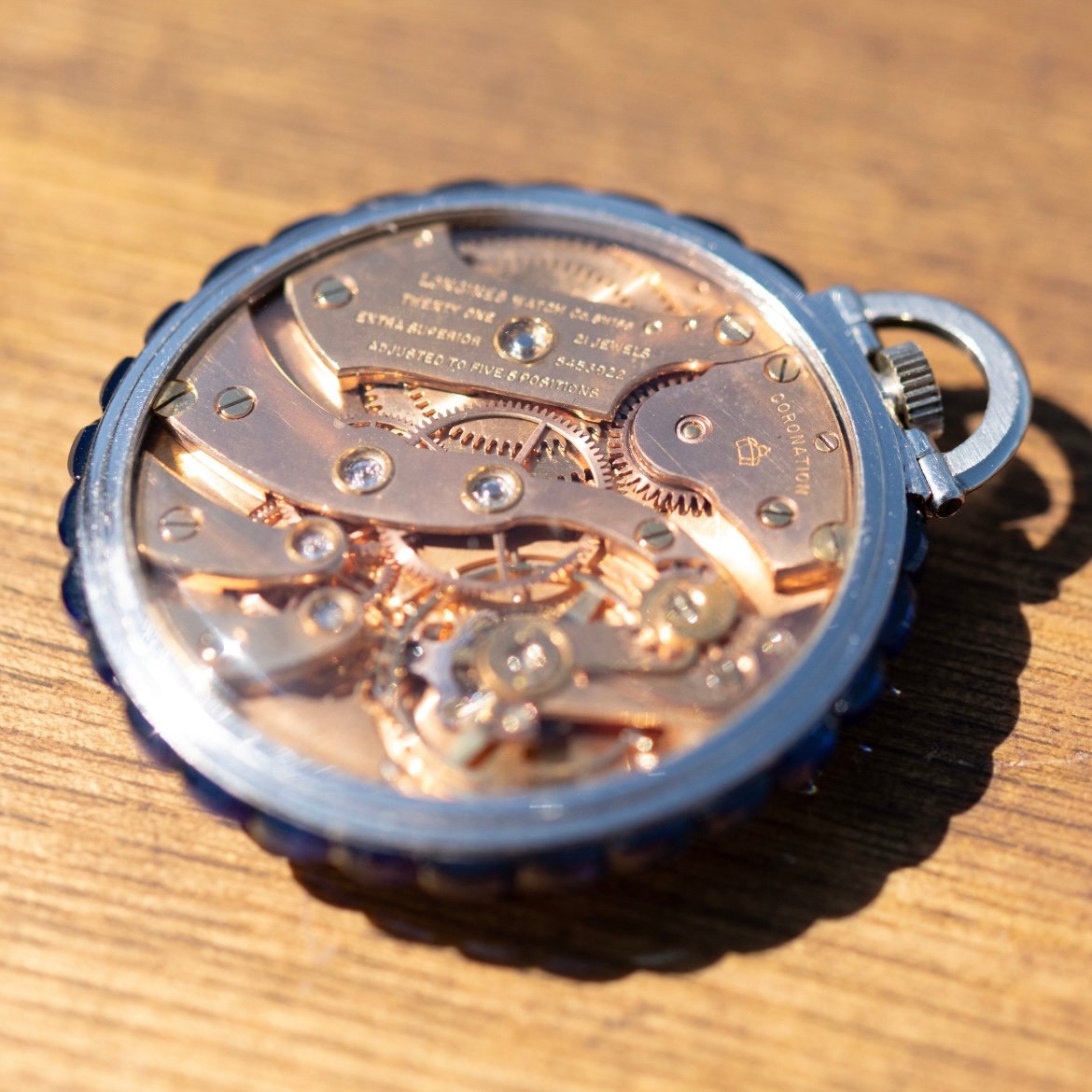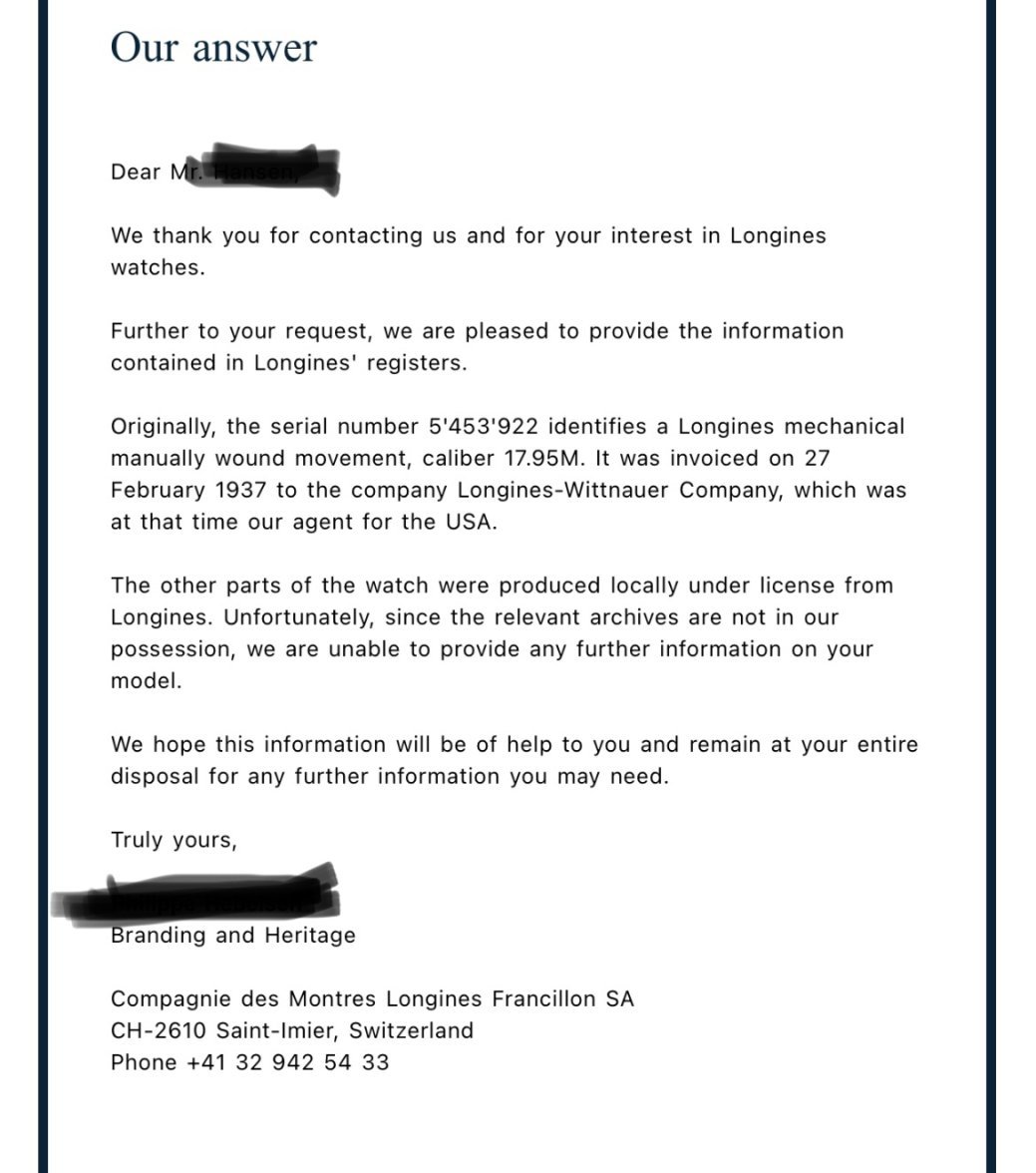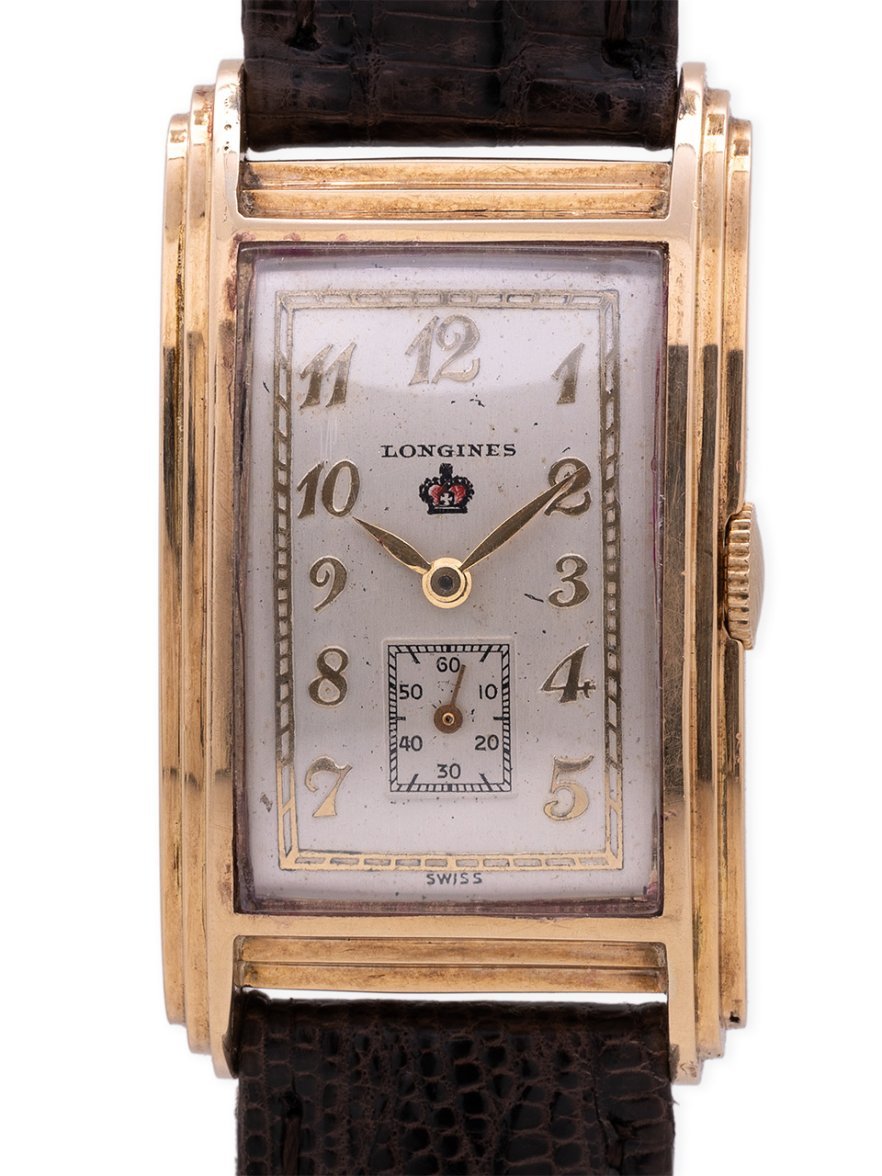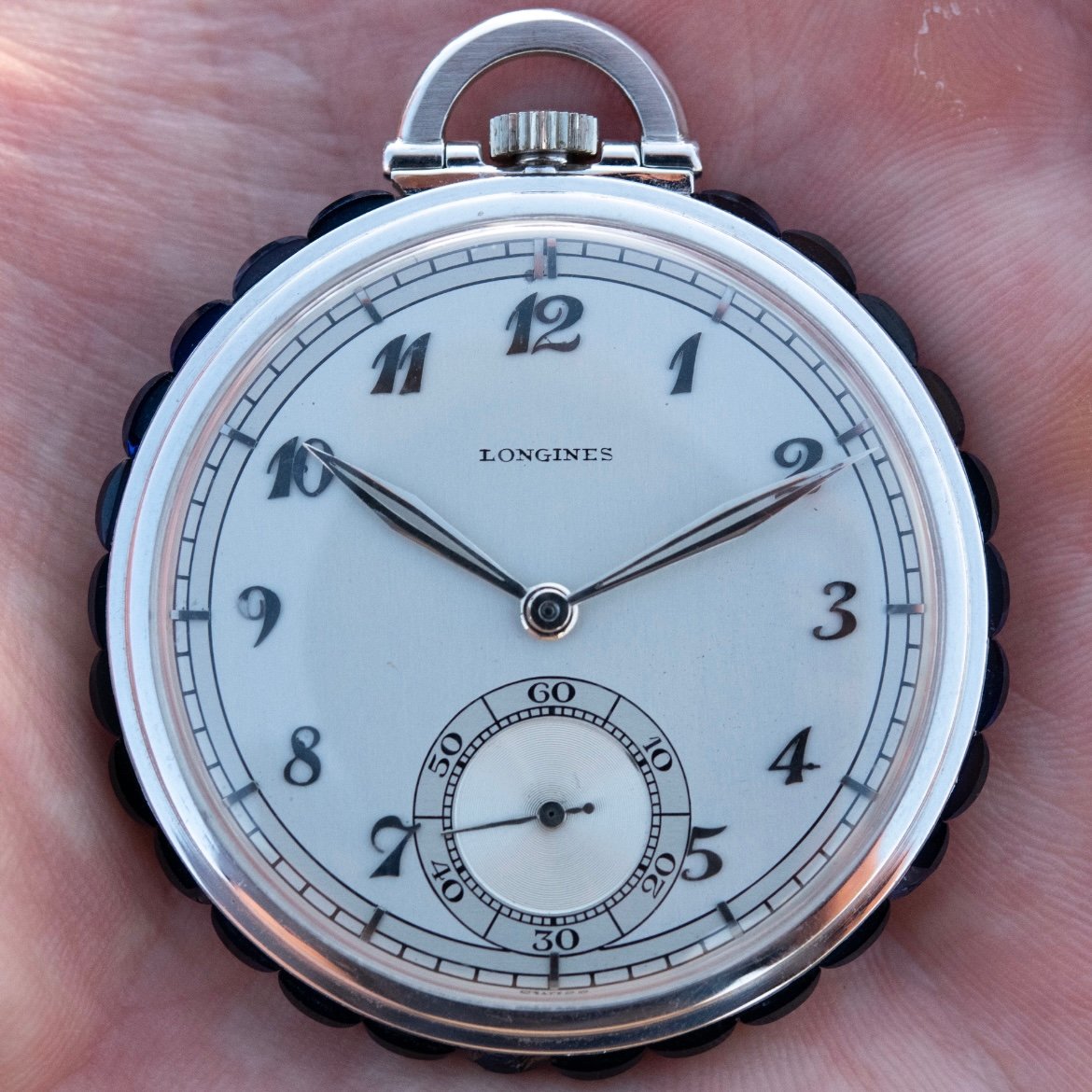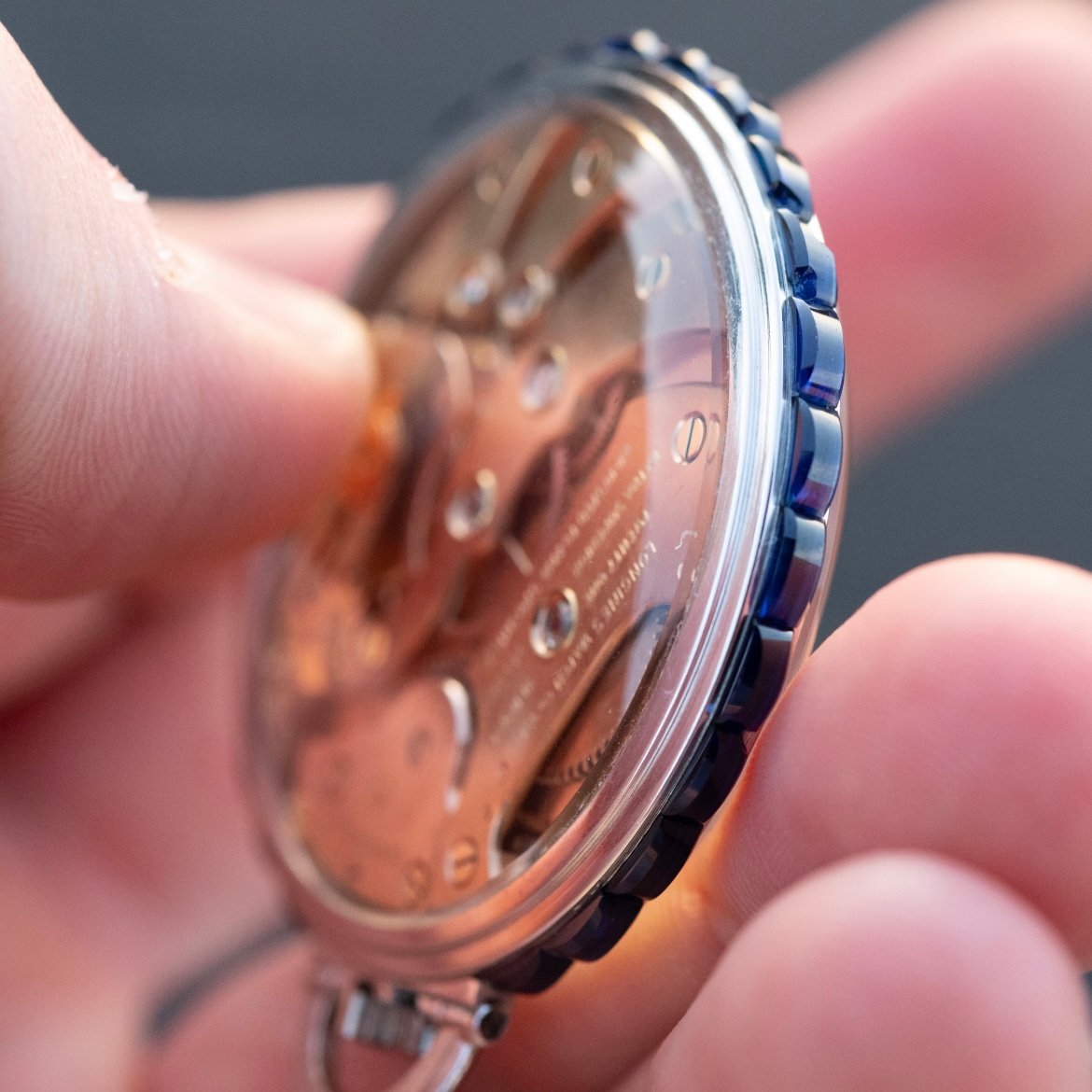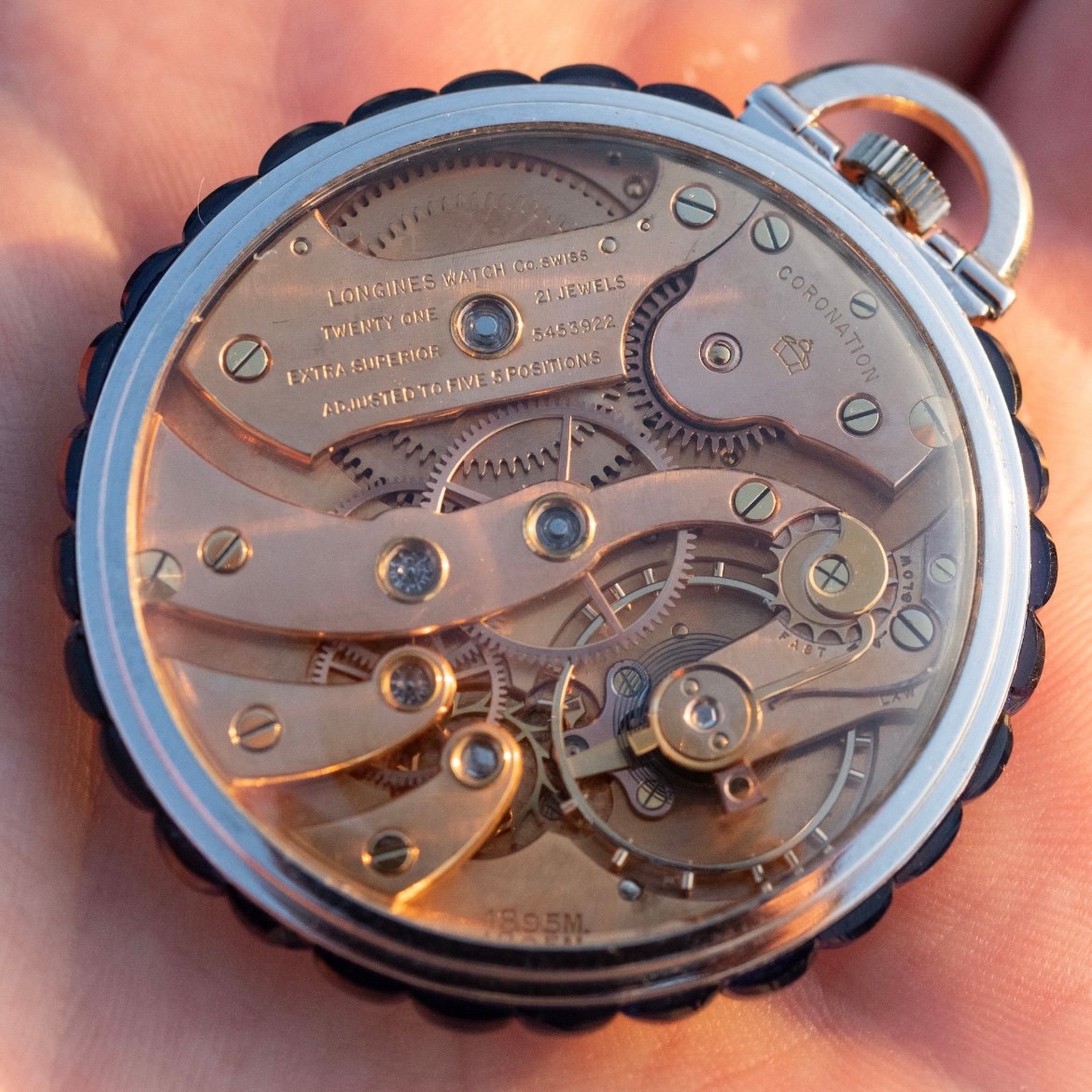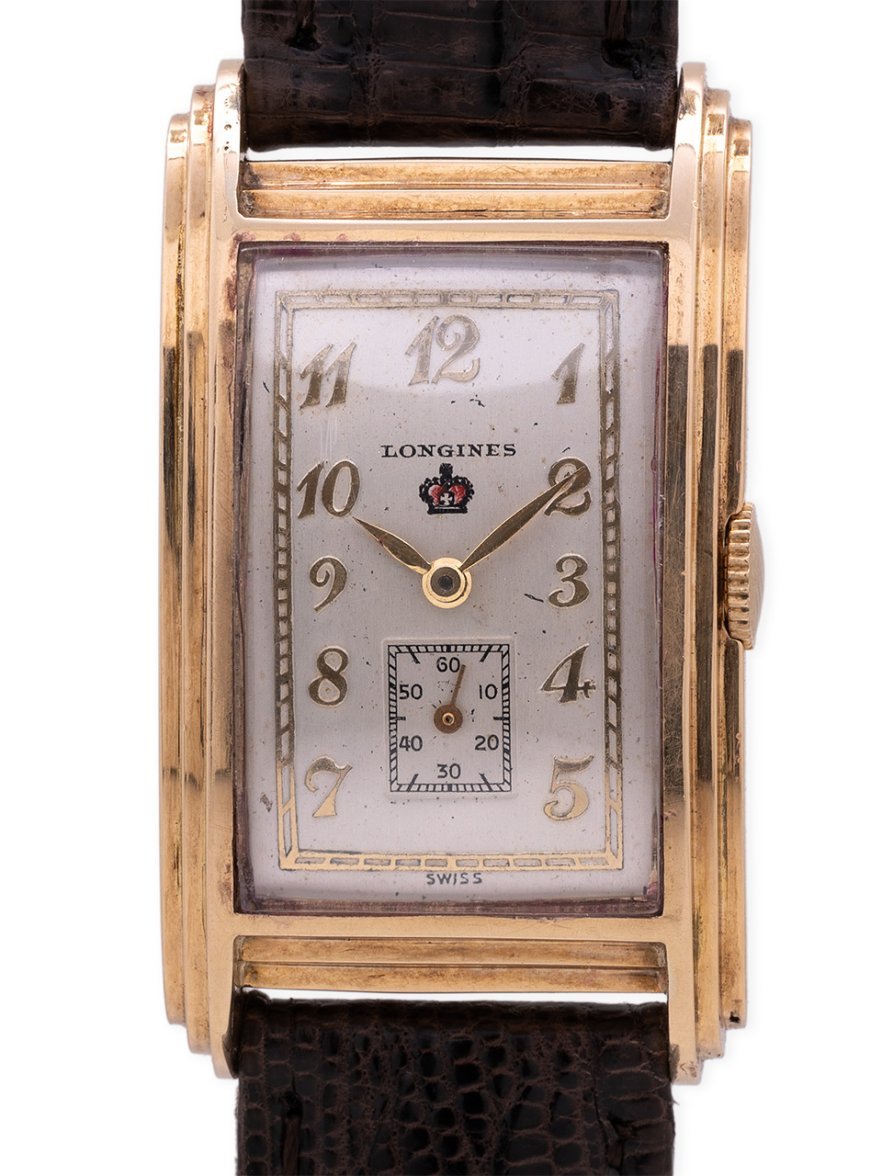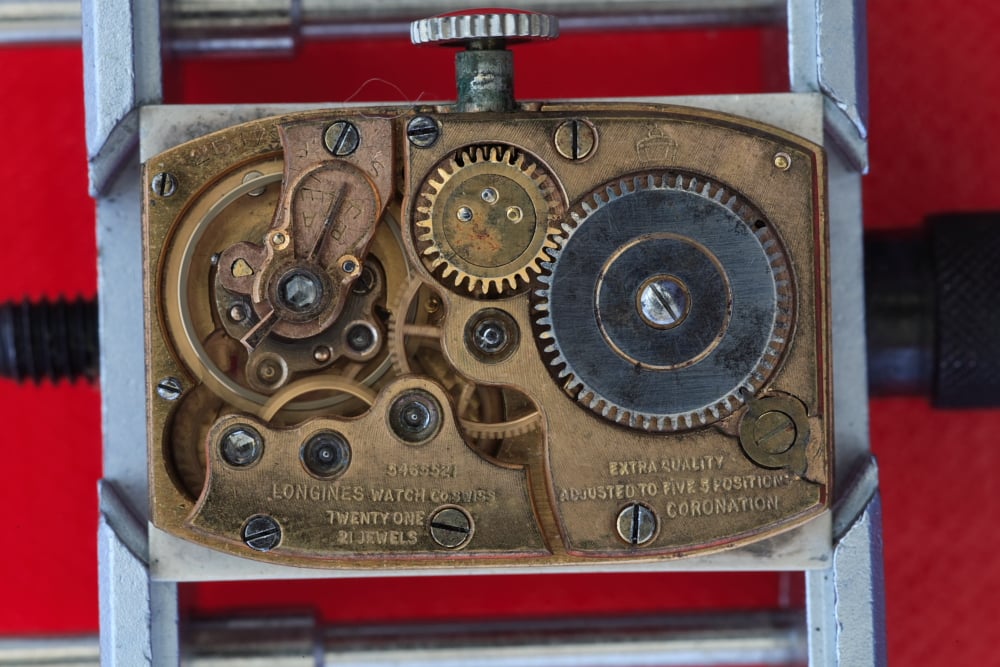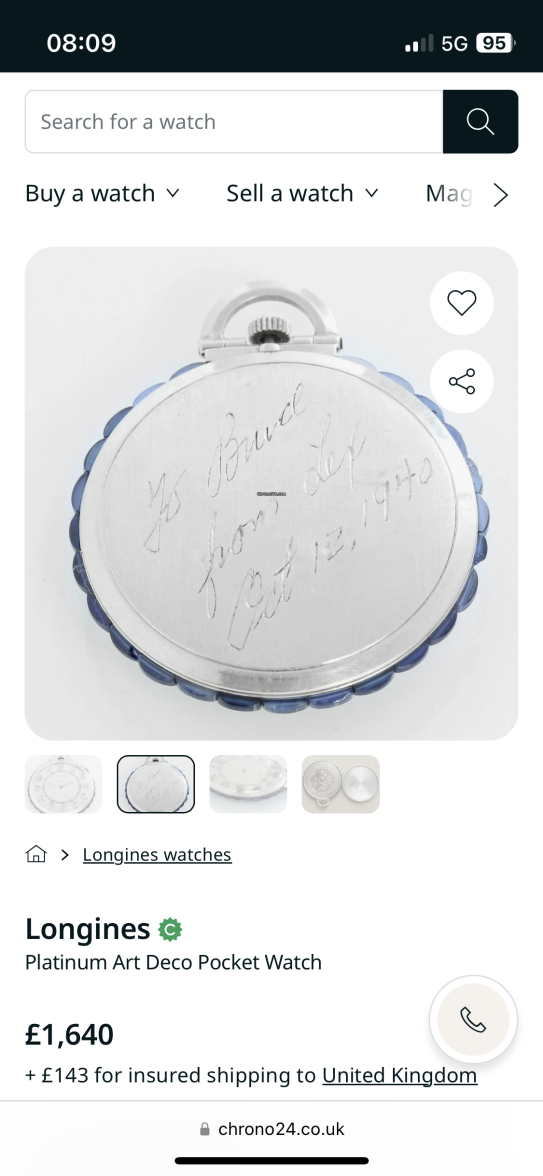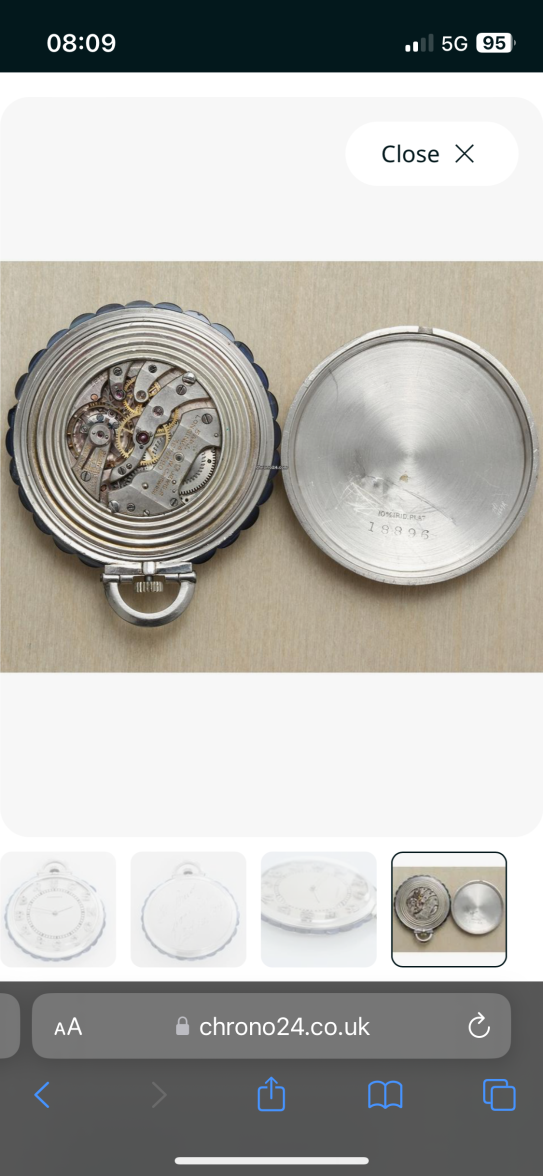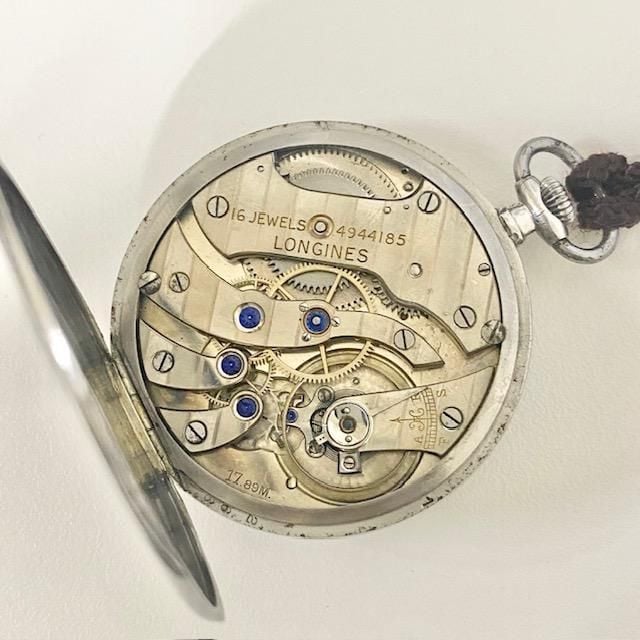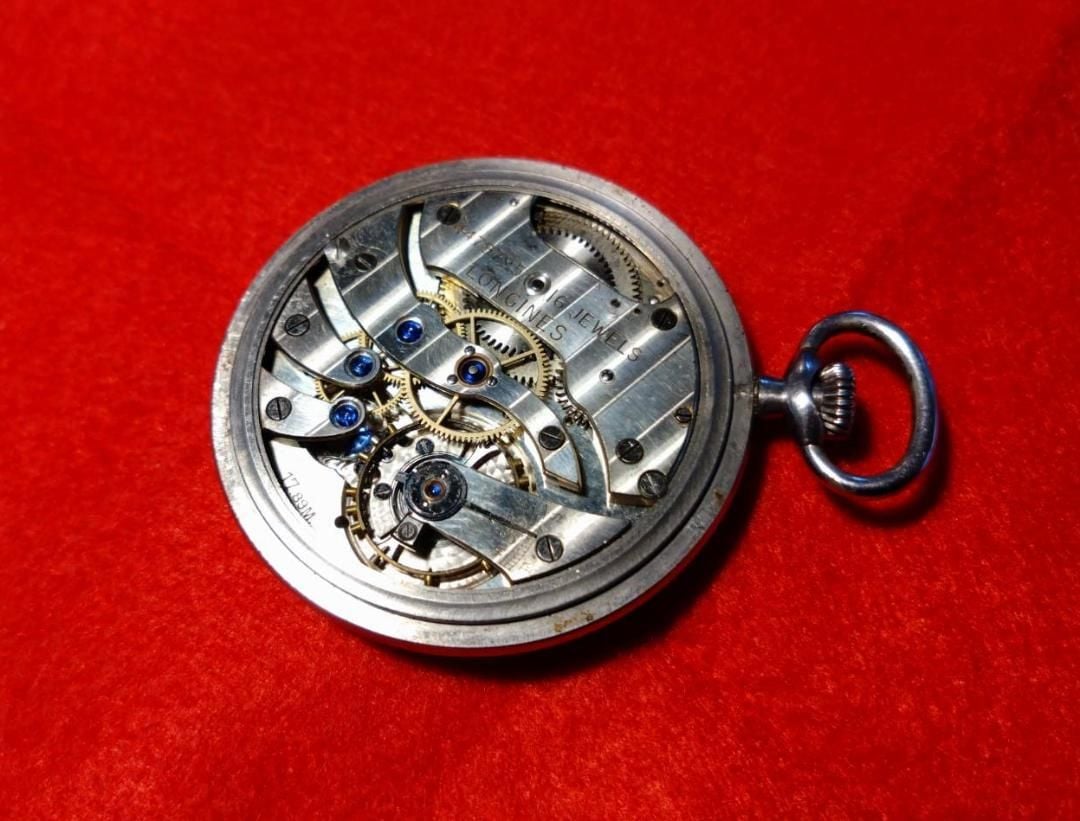J_pilot
·Hi all,
I wanted to create this thread to share a recent pickup, and hopefully to learn a little more about this watch, or others like it. At a local auction on Saturday, I won the below, unlike anything I've seen from Longines:
So… here’s what I know:
-Platinum case w. what appears to be a factory exhibition caseback (rear bezel identical to front). Caseband channel is set with 26 sapphires, several of which are chipped. No visible hallmarks with both bezels removed, although there isn’t much real-estate available. I’ll be interested to see if there are any identifiers on the inside of the caseband when the movement is eventually removed. I suspect the crown to be non-original.
- The dial/handset are stunning with a subtle two-tone effect. The finish is unlike anything I’ve seen, it almost seems to glow. The dial feet are silver, so I’m guessing it’s a silver base? I believe it is an “indelible dial”, as the text of the signature appears to sit almost proud of the surface. (@DirtyDozen12 , let me know if I’m misusing terminoIogy I’ve learned from you elsewhere in these forums! )
-The star of the show is the movement, of course. The general architecture is that of a 17.95M but we have 5 adjustments, an “Extra Superior” designation, and what appears to be diamond or clear sapphire jewelling (right down to the pallet stones!) and what I’m assuming (but not certain) is rose gold plate on… well, everything. Interestingly, the Archive response that was shared with me by the auction house fails to mention ANY of the bling, and identifies the movement only as a 17.95M, vs. the 18.95M it is stamped with. Googling around, it appears that 18.95M was the “extra superior” version of the 17.95M.
Now onto the more speculative half of this post - what is this thing?
From period adverts, it seems that at least the Longines Wittnauer company in the U.S. used the coronation of George VI/ Queen Elizabeth as a marketing opportunity, presenting them with three watches - a cocktail watch, a wristwatch, and a pocket watch. All three allegedly had “solid gold” movements with diamond jewels.
Credit: https://www.alamy.com/stock-photo/longines-advert.html?sortBy=relevant
According to the ad, a limited number of “royal” pocket, wrist, and cocktail watches were produced and sold as “replicas”, differing only from the coronation-presented watches in that they did not share the exotic movements. Interestingly, the watches pictured all have the same crown motif visible on my example’s movement.
I was actually able to find a sold example of the wristwatch “royal replica” here: https://wannabuyawatch.com/product/longines-14k-yg-coronation-king-george-vi-curvex-circa-1937/
This listing makes no mention of any special treatment to the movement, which seems to corroborate the statement in the ad.
After finding this, I thought I had a plausible theory as to the origin of my pocket watch: it was some kind of “showroom” example displayed by a U.S. retailer to help market the more serially produced “royal replicas”. It just made sense, given the sapphires, the delivery date, and critically, the display caseback.
Then I found this article, posted in 2006 by a Japanese user whose username translates to “The Quest Kid”:
http://tanqkozo.blog79.fc2.com/blog-entry-8.
In this post he, or she, shares a heavily worn, but similarly decorated 9L, complete with the coronation label and clear jewelling. Additionally, the author notes that they have seen pictures of a pocket watch with a similar movement in the book “The Clock King" by Takeshi Matsuyama (both translated with google, probably imperfectly). Is that pocket watch this pocket watch? A different one? Is this the book in question?
https://a.co/d/fkkWTXc
It might be worth the gamble, for $21. Regardless, the existence of the 9L movement raises more questions than answers for me. Did Longines serially produce a run of watches with these ultra-decorated movements? I’m looking forward to digging into this deeper, and of course would love to hear if anyone here has any further knowledge/insights.
Thanks for reading!
Juergen
I wanted to create this thread to share a recent pickup, and hopefully to learn a little more about this watch, or others like it. At a local auction on Saturday, I won the below, unlike anything I've seen from Longines:
So… here’s what I know:
-Platinum case w. what appears to be a factory exhibition caseback (rear bezel identical to front). Caseband channel is set with 26 sapphires, several of which are chipped. No visible hallmarks with both bezels removed, although there isn’t much real-estate available. I’ll be interested to see if there are any identifiers on the inside of the caseband when the movement is eventually removed. I suspect the crown to be non-original.
- The dial/handset are stunning with a subtle two-tone effect. The finish is unlike anything I’ve seen, it almost seems to glow. The dial feet are silver, so I’m guessing it’s a silver base? I believe it is an “indelible dial”, as the text of the signature appears to sit almost proud of the surface. (@DirtyDozen12 , let me know if I’m misusing terminoIogy I’ve learned from you elsewhere in these forums! )
-The star of the show is the movement, of course. The general architecture is that of a 17.95M but we have 5 adjustments, an “Extra Superior” designation, and what appears to be diamond or clear sapphire jewelling (right down to the pallet stones!) and what I’m assuming (but not certain) is rose gold plate on… well, everything. Interestingly, the Archive response that was shared with me by the auction house fails to mention ANY of the bling, and identifies the movement only as a 17.95M, vs. the 18.95M it is stamped with. Googling around, it appears that 18.95M was the “extra superior” version of the 17.95M.
Now onto the more speculative half of this post - what is this thing?
From period adverts, it seems that at least the Longines Wittnauer company in the U.S. used the coronation of George VI/ Queen Elizabeth as a marketing opportunity, presenting them with three watches - a cocktail watch, a wristwatch, and a pocket watch. All three allegedly had “solid gold” movements with diamond jewels.
Credit: https://www.alamy.com/stock-photo/longines-advert.html?sortBy=relevant
According to the ad, a limited number of “royal” pocket, wrist, and cocktail watches were produced and sold as “replicas”, differing only from the coronation-presented watches in that they did not share the exotic movements. Interestingly, the watches pictured all have the same crown motif visible on my example’s movement.
I was actually able to find a sold example of the wristwatch “royal replica” here: https://wannabuyawatch.com/product/longines-14k-yg-coronation-king-george-vi-curvex-circa-1937/
This listing makes no mention of any special treatment to the movement, which seems to corroborate the statement in the ad.
After finding this, I thought I had a plausible theory as to the origin of my pocket watch: it was some kind of “showroom” example displayed by a U.S. retailer to help market the more serially produced “royal replicas”. It just made sense, given the sapphires, the delivery date, and critically, the display caseback.
Then I found this article, posted in 2006 by a Japanese user whose username translates to “The Quest Kid”:
http://tanqkozo.blog79.fc2.com/blog-entry-8.
In this post he, or she, shares a heavily worn, but similarly decorated 9L, complete with the coronation label and clear jewelling. Additionally, the author notes that they have seen pictures of a pocket watch with a similar movement in the book “The Clock King" by Takeshi Matsuyama (both translated with google, probably imperfectly). Is that pocket watch this pocket watch? A different one? Is this the book in question?
https://a.co/d/fkkWTXc
It might be worth the gamble, for $21. Regardless, the existence of the 9L movement raises more questions than answers for me. Did Longines serially produce a run of watches with these ultra-decorated movements? I’m looking forward to digging into this deeper, and of course would love to hear if anyone here has any further knowledge/insights.
Thanks for reading!
Juergen
Edited:
